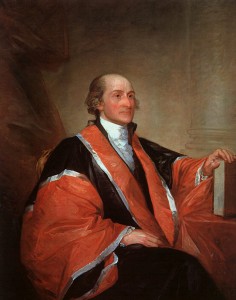 George Washington nominated John Jay as the first Chief Justice of the U.S. Supreme Court on September 24,1789. He served until his resignation in 1795, after having been elected Governor of New York. It would be inconceivable today for a Chief Justice of the Supreme Court to run for Governor of a State. An appointment to the nation’s highest court would be the pinnacle of any legal career. But things were very different in the late 1700’s. A New York newspaper even described Jay’s “promotion” to Governor. Being a U.S. Supreme Court Justice did not hold the prestige it does today. In fact, John Jay did not like the job, and complained frequently. Like other justices back then, he particularly disliked having to “ride circuit”, which involved grueling trips around the country to hear cases in the 13 circuit courts. Travel was by horseback, and the food and accommodations were not great.
George Washington nominated John Jay as the first Chief Justice of the U.S. Supreme Court on September 24,1789. He served until his resignation in 1795, after having been elected Governor of New York. It would be inconceivable today for a Chief Justice of the Supreme Court to run for Governor of a State. An appointment to the nation’s highest court would be the pinnacle of any legal career. But things were very different in the late 1700’s. A New York newspaper even described Jay’s “promotion” to Governor. Being a U.S. Supreme Court Justice did not hold the prestige it does today. In fact, John Jay did not like the job, and complained frequently. Like other justices back then, he particularly disliked having to “ride circuit”, which involved grueling trips around the country to hear cases in the 13 circuit courts. Travel was by horseback, and the food and accommodations were not great.
Born in New York City in 1745 to a wealthy mercantile family, Jay was educated at Kings College, which is now Columbia University. He was admitted to the New York Bar in 1768. He built a successful law practice, although he was described as “”neither a brilliant advocate nor a profoundly learned lawyer nor a master of the technique of practice.”
Along with his fellow New Yorker Alexander Hamilton, he penned a number of the articles that form what is now known as the “Federalist Papers.”
Prior to his appointment by Washington to the Supreme Court, he did not have a great deal of judicial experience. He did, however, serve for a short time as Chief Justice of the New York Supreme Court.
The Jay Court heard only four cases: West v. Barnes, Chisholm v. Georgia, Georgia v. Brailsford, and Hayburn’s Case. Since the workload was so light, Jay actually engaged in many other activities while serving as Chief Justice. For instance, in 1794 George Washington sent him as an envoy to Great Britain to negotiate a treaty. Jay was criticized for accepting this position while remaining on the Court, since this was an obvious violation of the concept of “separation of powers” embodied in the Constitution. At the time, tensions had risen between the two nations and war was a distinct possibility. Jay continued to serve as Chief Justice while living in England, a circumstance that would be inconceivable today. The resulting agreement, known as the Jay Treaty, was very controversial, but it was eventually ratified. Jay was credited with staving off war, but his reputation suffered. He was always suspected of being a British loyalist. He commented that he could travel at night between Boston and Philadelphia by the light of his burning effigies.
Although many historians have written that the Jay Court rendered no important decisions, John Jay’s opinion in Georgia v. Brailsford asserts for the first time in U.S. history a jury’s right to nullify a verdict. Jay wrote that “It is presumed, that juries are the best judges of facts; it is, on the other hand, presumed that courts are the best judges of law. But still both objects are within your power of decision… you [juries] have a right to take it upon yourselves to judge of both, and to determine the law as well as the fact in controversy.” Read more about this decision in a prior post about juror nullification.
For more information on the Jay court, including a discussion of the few other decisions handed down during his tenure, read this post on the history of the first U.S. Supreme Court.




{ 2 trackbacks }